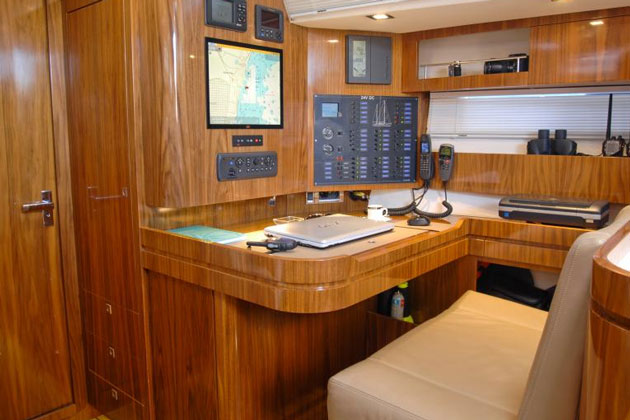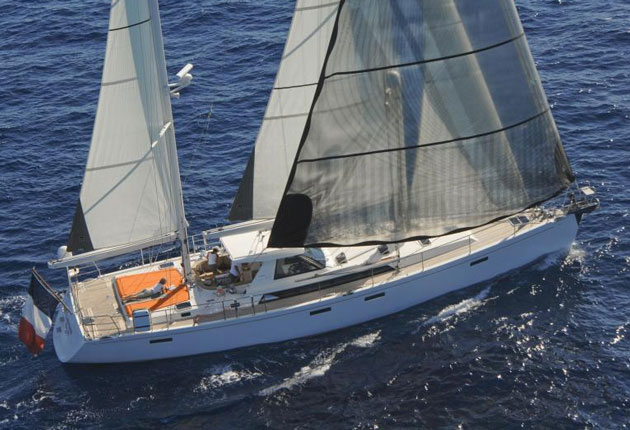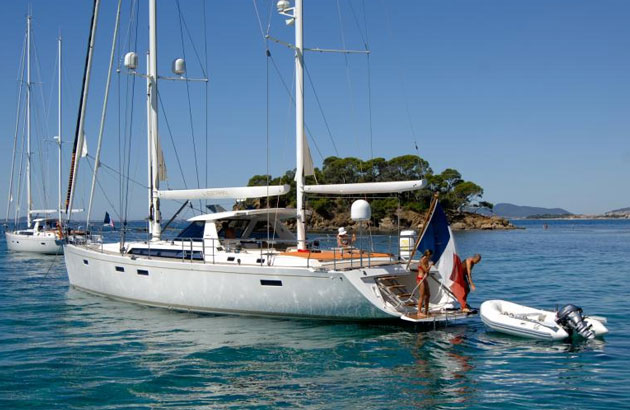Amel 64: A Bluewater Cruiser With Choices, Choices, Choices
The new flagship of the Chantiers Amel line, the Amel 64, redefines personalization in a bluewater-capable cruising sailboat.
Choice is what you’ll get with the new Amel 64, the flagship of the Chantiers Amel fleet, a departure in some sense from the French builder’s traditional approach—and a welcoming of a new era of personalization. The 64 is a ketch-rigged production cruising sailboat, which is not a new concept for the builder. Amel has always subscribed to the notion that smaller sails are easier to manage. They have offered a split rig since the days of the first Mango and Maramu models. The usual genoa and mainsail are supplemented with a saytsail and mizzen. Multiple combinations, goes the theory, provide a choice as to how to manage the wind and therefore emphasize safety offshore.
The 64 (now along with the recently introduced 55) is designed by someone other than company founder Henri Amel, who passed in 2005. Naval architects Berret Racoupeau created something different, but something that still fits Amel’s customer appeal. Amels have been a bit utilitarian in the past, with no-nonsense features that made them tough but practical; faux teak on the decks, virtually no exterior wood accents, easy access to the engine and systems, and so on. That practicality has remained. But what was added by Berret Racoupeau is a significant emphasis on luxury, both above and below decks. No wonder - the buyer of a 64-foot boat whose starting price hovers around $2.8 million is not likely looking to rough it.
Furthermore, this Amel offers a variety of optional equipment. Early Amels were loaded with gear and options chosen by Monsieur Amel himself. Much like Henry Ford’s approach – you could have had any color, so long as it was black. Amel turned out boats that were considered to be perfect at launch, so there was no options list. Not so any more. Personalization is now down to the detail—the owner even specifies the dishes to be used, and cabinetry is built to accommodate them.
On Deck
The different vibe of the new flagship is evident from the moment you step aboard. The electric transom drops down to create a swim platform, perfect for boarding from the dock or the dink. The cavernous aft interior is designed to hold an inflatable with an outboard, which is hoisted into the garage by an electric winch and rollers. If you’re in Europe where Med-mooring is a must, you can skip this whole thing and step aboard from the dock via the electrically-deployed passerelle complete with an integrated self-raising handrail. And if you don’t want a dinghy garage – pas de probleme – just eliminate it.
A few steps up you’ll land on the aft deck, which is separated from the cockpit by an enormous sunpad that looks more like something found on a power yacht. Two built-in seats flank the pushpit and a life raft is integrated into the starboard rail. The topmost guardrail is solid stainless-steel all around the vessel, with secondary and tertiary lifelines below.
Like all recent Amels, the 64 is a center cockpit design that sports a very attractive integrated hard dodger. A new electric hardtop extends aft from this structure to cover most of the seating area for al fresco dining unencumbered by weather. The cockpit hasn’t changed much since Henri founded the company in 1961. The helm is still forward and offset to port. Not just a binnacle, the dashboard ahead of the Star Trek-esque helm-seat positions all electronics and switches within easy reach of the captain. Additional engine access is via the cockpit sole.
On the bow, you can choose one windlass or two to manage the primary and secondary anchor. Here, a large sail/fender locker also contains a watertight bulkhead, one of six on the vessel. Designed to ply distant waters, Amels have always put safety first. Whether that’s collision bulkheads or a protected full-skeg rudder, these are details that the builder is unlikely to ever change.
All except the mast-mounted winches are electric and Reckmann furlers do the heavy work on both the staysail and genoa. The Amel 64 is a 24-V vessel and has plenty of power to manage the systems aboard. There’s a 735 amp-hour house bank plus batteries for thrusters, the engine, and a 19.5 kW Onan genset. Auxiliary propulsion comes via the 160 hp Steyer diesel. This engine sits facing aft, with a short shaft and a four-bladed prop sitting up close to the aft end of the fin keel. The propulsion therefore, comes from the center of the boat. MaxPower bow and stern thursters help in tight docking situations.
A Reworked Interior
The Amel 64 features a three-cabin and three-head layout that is strikingly different from Amel’s usual accommodations, as well as from other bluewater boats in its class. The galley at the bottom and to starboard of the companionway resembles the chef’s station on a catamaran, with lots of countertop acreage and a nice open feel where multiple people can work simultaneously. With an island toward midships, it creates a snug place to prepare meals even under way and heeling. A four-burner stove, sink, Corian counters, and microwave provide the tools for culinary comfort. An electric oven and a full-sized stainless steel dishwasher are included as is the option of a second fridge (remember that huge genset?)
The saloon takes advantage of the 18–foot beam and incorporates both a formal dinette with a fold out table that will seat eight, as well as a separate lounge with a low coffee table and sofas. Discreet living areas were designed to break up the cavernous interior, so it would be safe in a seaway.
The nav station is ahead of the galley and to starboard. It’s not ideal to have a nav station so far from the companionway, but since just about all electronics and controls for key systems are duplicated at the helm, the choice of its location is a bit moot.

The well-designed nav station chair in the Amel 64 will put any navigator at ease, as will the hull port that provides a bit of visibility to one side.
What’s unexpected is the location of the master—forward, in a center cockpit design. It has a walk-around island berth, oodles of stowage, and a very well-proportioned head and stall shower. The aft section splits into two cabins, each with stand-up headroom. To port is one with a queen bed, and to starboard, one with two twins that can be connected.
The entire central area between the saloon and aft cabins is dedicated to the engine and systems space, with a door that provides crouching access into the engine room. Everything from dual Racor fuel filters to the 5,000-watt inverter can be worked on easily, which is a nod to the needs of self-sufficient bluewater cruisers.
The interior has a high gloss polyurethane finish in one of the better shades of walnut, and a choice of other woods is also offered. The styling is minimal but not all funky-angular like some of the more extreme Euro-chic design today. It looks and feels like a home, which was the goal. A variety of upholstery and finishing touches are available from classic to whimsical, although any American owner looking for this caliber of vessel is unlikely to opt for whimsy.
Coming in over 30 tons, the Amel 64 is not a light boat. It will take a bit of wind to move her despite her slippery hull. However, with over 2,000 square feet of sail area, she’ll do nine knots in 15 knots of breeze on the beam and not think twice about it.
| Specifications | |
|---|---|
| Length | 64'4" |
| Beam | 18'5" |
| Draft | 7'10" |
| Sail area (total) | 225 m2 |
| Displacement | 82,675 lbs |
| Fuel capacity | 370 gal. |
| Water capacity | 238 gal. |
Amel has built more than 2,000 hulls in various sizes and configurations. The 64 took a bold step in a new direction, but not so bold as to not be recognizable to the market that has made Amel what it is today. With a mix of tried-and-true cruising concepts and a bit more leeway in terms of amenities, Amel has advanced their offering without losing continuity.
The La Rochelle yard is an employee-owned cooperative. Henri Amel insisted on this arrangement before his death, since it was the hard work of his employees that brought the company back after a devastating fire in 1968. As a result, there has always been a family feel to the company and a lot of pride goes into building an Amel. Now, there’s choice as well. Consider yourself empowered.
Other Choices: The Hylas 63 is another serious cruiser in this size range, as is the Oyster 625. Remember, however, that neither will be found with the ketch rig.
See Amel listings.
For more information, visit Amel.



















